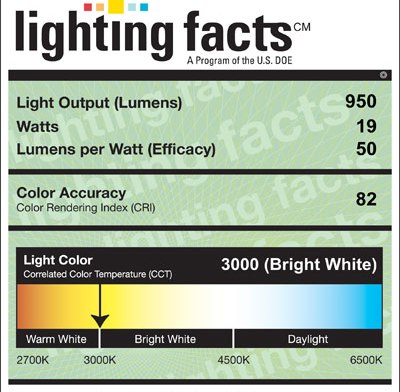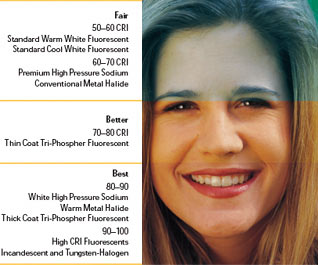Color Rendering Index (CRI) helps match human perception of color quality
Metric’s future in limbo as proposed new standard stalls in committee
There are two key measures used when evaluating lighting sources:
- Color Rendering Index (CRI)
- Correlated Color Temperature (CCT)
CCT measures the color of a light source using Kelvin (K) temperature, which indicates the warmth or coolness of a lamp’s color appearance. The lower the Kelvin temperature (2700–3000 K), the warmer the color of the light, while the higher the temperature (3600–5500 K), the cooler, and more bluish, the light appears.

Lighting Facts label
Typically, warm light sources are used in retail, restaurants and home applications to create a sense of comfort and warmth. Cooler lighting sources provide a higher contrast and are preferred for offices and similar applications to create a sense of alertness.
Rendering natural color
But CCT does not indicate how natural the colors of objects appear when illuminated by a light source. In fact, two lamps can have the same CCT but render colors much differently.
Natural and realistic color rendering, also called color accuracy, is essential for illumination applications such as retail, where it’s important that products render the correct color and appear inside the store just like they do outside in daylight.
Over 40 years ago, the Austria-based International Commission on Illumination (CIE), the standards-setting body of the global lighting industry, developed CRI to indicate how colors appear under different light sources, particularly fluorescent and high-intensity discharge lamps, and to best correspond them to a human’s perception of color quality.
Measuring color shift
Because most objects are not a single color but a combination of several, light sources lacking in certain colors can change the apparent color of an object, also known as color shift.
Specifically, CRI measures on a scale of 0 to 100 how a light source shifts the location of eight specified pastel colors compared to the same colors lit by a light source of the same CCT.
Eight color samples used in calculating CRI
A CRI of 100, or perfect color rendering, means the light source renders the eight colors exactly how the reference light source renders them. A light source with a CRI of 80 or higher is considered by the lighting industry to provide excellent color rendering for most indoor applications.
Typical CRI values for commonly used light sources:
| Light source | CRI range |
| Incandescent | 100 |
| Ceramic metal halide | 85 to 94 |
| T5 fluorescents | 80s |
| T8 fluorescents | 75 to 98a |
| Quartz metal halide | 65 to 70 |
| T12 fluorescents | 58 to 62 |
| High-pressure sodium | 22 |
Note: a. T8 lamps with CRIs in the 90s offer lower efficacy than other T8 lamps.
Source: Department of Energy
CRI: the color quality metric of choice?
CRI is the only color rendering metric used by the global lighting industry, and is generally considered to be a more important lighting quality than CCT.
Yet, over the years, as new technologies made their way to the marketplace, and demand for better lighting placed more scrutiny on the products available, shortcomings of CRI became evident and too big to ignore.
CRI Drawbacks
One problem industry has with CRI is that it can give rather high scores to light sources that render some saturated object colors, particularly red, very poorly.
CRI has also been found to be an inaccurate, unreliable predictor of color preference of solid-state lighting products such as light-emitting diodes (LEDs), which emit a much different light than fluorescent or HID lamps, and can result in lower or even negative CRI values for some of them. For instance, some LED products with a CRI as low as 25 can produce white light that actually make object colors appear more vivid.
And because CRI only evaluates color rendering, also known as color fidelity, it ignores other aspects of color quality, such as chromatic discrimination and observer preferences.
CQS Debuts
To help remedy these drawbacks, CIE established a technical committee in 2006 to develop and recommend a new color rendering metric.
In June 2010, Wendy Davis, chair of the committee, debuted the Color Quality Scale (CQS), which she developed with colleagues at the National Institute of Standards and Technology (NIST), the federal technology agency that works with industry to develop and apply technology, measurements, and standards.
The proposed metric is believed to offer a superior indication of what humans perceive as superior color rendering compared to CRI specifications.
Where CRI relies on a evaluation of how a white light source illuminates eight pastel colors, CQS uses 15 colors, including samples with much deeper color – such as deep reds where CRI proves especially inaccurate.
Endorsing the new CQS measurement, James Brodrick, lighting program manager for the DOE’s Building Technologies Program, said, “Regardless of the type of light source, the CQS represents the color rendering qualities of white light more accurately than the CRI and is a far better predictor for colors that have a high red content, such as skin color and wood finishes – which is one of the CRI’s major weaknesses.”
The proposed CQS, still being debated at the CIE’s committee level, is intended to eventually replace the CRI as a new international standard for general illumination evaluation of traditional lighting technologies and solid state lighting sources.
But the new metric may never see the light of day.
Is CQS headed toward failure?
While it gains support in the U.S. lighting industry, the committee is deadlocked between those who see it as a solution for measuring color quality of solid-state lighting and those pushing for a metric that is more similar to CRI, said Davis, who recently left her position at NIST to take a position as a senior lecturer and illumination program director at the University of Sydney.
“We’ve been working for over five years now and have been unable to reach an agreement, so far,” Davis told Lumenistics. “The CIE requires unanimous agreement to issue a recommendation, and this committee has [approximately] 40 members. As you can imagine, it’s been tough. I’m not sure if the committee will be successful.”
It certainly hasn’t been in the past. The CIE has attempted to revise the CRI several times throughout the 1980s and 1990s “and every committee ended in failure,” Davis said. “If that happens now, which is very much a possibility, I wouldn’t be surprised if some other standards organization were to take up the issue.”
So, for now, CRI remains the only internationally recognized color rendering system. Whether the lighting industry, especially the solid-state category, will continue to use it for evaluating lighting applications remains to be seen.
###
Sources:
- GE Lighting website
- US Department of Energy website
- National Institute of Standards and Technology website
- Lighting Research Center website



